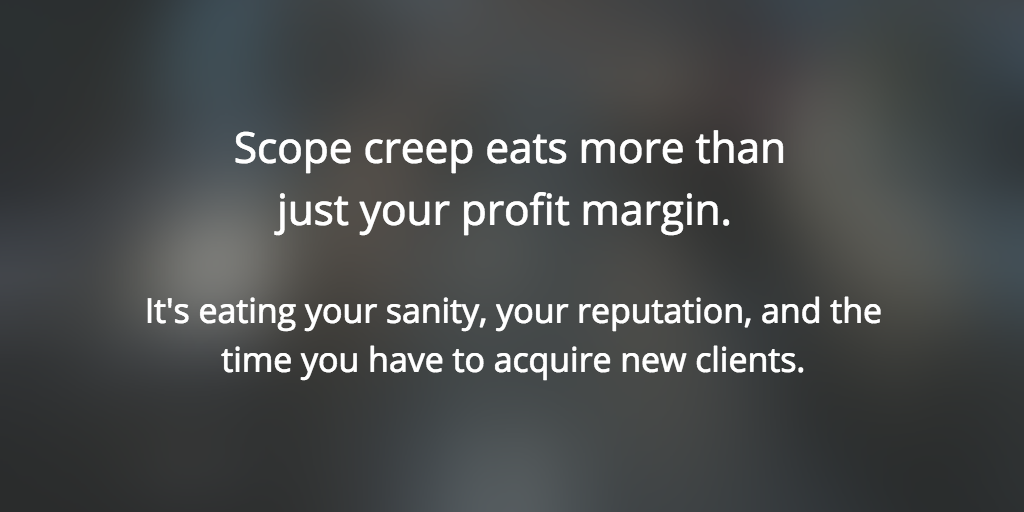
If you're a freelancer or project manager, you've probably had one of these conversations with your client:
"Great work! Can you add a big red button at the bottom of the website, too?"
"Thanks for your hard work! It would be great to have another paragraph about this hashtag we just created, and a link to our social media. Can you whip that up by tomorrow?"
"Super job! I'm thinking an image with that quote overlayed would make this perfect."
It's called scope creep and it's eating more than just your profit margin. It's eating your sanity, your reputation, and the time you have to acquire new clients.

Let me tell you how.
The term originated from software project management. As project managers (like the rest of us) discovered that it wasn't a ton of extra work to just add that ONE extra feature.
Soon, one extra feature turned into two. Which turned into two. Which turned into eight. Which turned into a missed deadline and an unhappy client call.
It's easy to slip into this pattern without noticing you're doing it. Here are 3 simple, effective ways to prevent scope creep in your project plan, and deal with it once it's upon you.
1. Define your Terms Before you Agree to Anything
In any conversation, it's 100% critical to be on the same page with each other. No brainer.
This is the most important component to preventing scope creep, so let's jump into an example:
Your client says "Hey, I want you to write a speech about women's healthcare."
If you want to fail at project management, start without asking these critical questions:
- Who is your audience?
- How do you want your audience to feel?
- What would happen that would make this speech a 'win' for you?
Be crystal clear about what 'success' actually means! If your expectations for project scope are not aligned with your client's, you're screwed before you start.
1.png)
As a freelancer, you can't afford a contract without a sterling referral. Referrals are our lifeblood.
Be so specific about each of the features of your deliverable that you will feel comfortable going back and pointing to it later. I guarantee you'll end up doing this at some point.
Good responses from your client might sound something like:
- "The speech should be 4 minutes long."
- "I'm talking to 24-34-year-old women who are at risk for heart disease because of a chronic stress disorder."
- "They should leave the talk feeling capable and confident in themselves to change their lives."
- "A major win would be if someone came up to me after my talk and shared their personal story."
You can't guarantee someone else's behavior, like a standing ovation or a definitive number of sales. Don't promise you will.
But that last bullet is a good goal to shoot for. It encourages you to add a call to action at the end of your client's speech that can put the odds in your favor.
In this case, you might have suggested that the client actually make an 'ask' of the audience:
"Tweet at me about your story, or come see me at table 9 so we can talk about your personal experience."
This won't guarantee the 'major win' scenario but it can increase the odds.
Be very specific about project scope
By listing the specific "features" you want to have completed in your contract, you'll have a project plan failsafe.
So when they ask "Can you add this extra button at the bottom of the page?"
You can confidently say:
"I can absolutely add that feature for $ x."
2.png)
2. Avoid Pricing your Project Plan by the Hour
I get a lot of pushback on this, but I firmly believe that you should avoid charging by the hour whenever possible. This is another preventative measure to knock out scope creep before it happens.
Hourly rates just mean that your client will be looking at the clock, trying to cram in as much as possible, and riding you hard on your deadline.
It'll also encourage them to ask for additional features that they might feel are already in your contract.
This means that when you get to the end of the project, you might be well over the budget you quoted them. Even though you might have both agreed that you should continue to work, your client might gripe about the price.
They might not even tell you that they're annoyed. They might just walk away and tell their friends.
Referrals and references, people.
You want to make your client feel like they got the deal of their life.
Don't allow the opportunity for scope creep to ruin your relationships!
Hourly rates won't allow you the creative space to perform your best, ask the right questions, and edit/revise. It won't allow you to focus on the project that's in front of you. It only creates pressure to cram more product into less time.
It optimizes for speed, not quality!
Hourly rates also hide a psychological phenomenon. The market may be willing to pay a certain price for a job, but a completely different price for your time.
Compare these two proposals:
- Option 1 - "I'll get this work done for $1500, no problem."
- Option 2 - "I'll get this work done for $1500, and it'll take me 3 hours."
They sound totally different.
Your client might be willing to pay the fair market price for the work, for sure. But if you reveal your proficiency by projecting hours, you could be leaving serious money on the table.
Consider the Ethical Bias
It incentivizes you to take your time with the project.
This is bad news for everyone. As a freelancer, it's your job to deliver amazing results at a great market price in a reasonable amount of time.
Don't lose focus of the "fair market price" part. Ask for what the market is paying, not for what you think your time is worth.
By charging the market price, you'll be able to focus on the project at hand and not the clock. You'll have the headspace to do your best creative work.
And the best of all: you and your client will be on the same page about how much everything costs. No surprises when you run into a problem and need to bill 5 more hours to figure it out.
This means extra features cost $ x, and not x hours. Being predictable is being safe and being safe makes your client feel happy and secure with you.
Trust, baby. It's all about building trust.
How am I supposed to quote a project plan without estimating how long it's going to take?
- Break up each component into it's simplest form. Literally put them all in a list and order them based on priority and include any dependencies.
- Show the list to your client and make sure you've thought of everything.
- Agree on the list.
- Total up the amount of time you honestly, truly, conservatively think it'll take to do your best work on each.
- Take the sum.
- Now multiply it (somewhere between 25% and 200%, depending upon the client and your track record of accurately predicting your time)
This will allow you to plan for uncertainty, and for the opportunity to either deliver ahead of schedule or to add a layer of polish.
Project Manager Pro-tip
Adding a layer of polish (AKA "gold-plating") is riskier than you think. I'd recommend delivering ahead of schedule instead. You always risk building something that the client doesn't actually value if you go the other route. Unless your client has been involved deeply and you are certain of the outcome, don't roll the dice on this.
Your client doesn't care if a tree fell through your house. They don't care that your car blew up. They're relying on you to get their work done by deadline!
It'll also allow you to do something that is tricky when you reveal your hourly rate.
You can deliver ahead of schedule for the same price.
If you'd have revealed your hourly rate, your client would have said:
"Hey! That's not fair! You billed me $3,500 because you said it'd take 100 hours! I'm paying you $3,500 and it only took you 60 hours!"
When you don't reveal your hourly rate, your client says "Oh man, this is great. We paid him $3,500 to get this done by June and now we're 2 weeks ahead of schedule!"
See the difference?
3. Outline a Contingency in your Project Contract
What happens if everything goes well, but we both decide to add something?
This should be built directly into your contract.
Your client is going to be much more amicable when the conversation comes up if you've already talked about how both of your are going to behave.
If you don't have this clause in place, you're setting yourself up for failure before you start. The conversation is going to come up. Everyone should already be prepared for it.
Some freelancers go as far as to quote a 'premium' rate for additional features. This can incentivize clients to double check and make sure they've included everything they need.
One way to do this without revealing an hourly rate is by literally writing out what's included and what's NOT included.
Even if you get everything in writing, a client can still feel duped because they didn't read the 'fine print.'
You're building a relationship that is built on trust. Don't just get them to sign the contract. Get them to understand it.
Remember the prioritized list?
This will come in handy when you need to talk contingency.
If you end up with a delay or complication, you'll need less time from your client to make a decision about how to move forward.
More Resources
If you want to go above and beyond, check out some of these extra articles that we felt had some value for readers. You deserve ALL the information!
For Project Managers:
- Preventing Scope Creep - Bidsketch
- Managing Scope Creep - MBO Partners
For Writers:
- Weapons for Fighting Scope Creep - Make a Living Writing
For Freelancers:
- Scope Creep: How to Tackle a Freelancer's Nightmare - Nuke Blogger
- What is Scope Creep and How Can Freelancers Handle It? - Payoneer
- How To Avoid Scope Creep as a Freelancer - Money Nomad
- How To Deal With Scope Creep - Your Freelance Career
For IT and Software developers:
- Seven Steps for Avoiding Scope Creep - Tech Republic
For people who don't believe in Scope Creep:
- Stop Preventing Scope Creep - Chris Lema
Thanks for reading!
Did you feel like we're missing something? How do you #CrushScopeCreep?Share with the freelance community on Instagram and Twitter.
Enjoy the Article? Spread the word:
Preventing Scope Creep: A Deadly Problem for your #Freelance Business https://t.co/BD2jm4T3nk pic.twitter.com/DUQF1qvbX0
— Harpoon (@HarpoonApp) April 19, 2016







